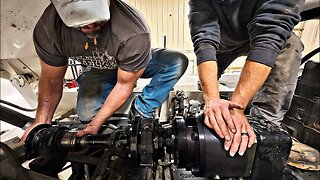Premium Only Content

Subsea Multiphase Flow Assurance and Flow Pattern Maps Online Course
Pipeline–riser transportation systems are frequently used in the offshore oil industry and are the main approach to transport oil and gas from oil wells to offshore platforms. In general, a pipeline–riser system has two key components: the sinuous pipelines on the seabed covering about 10 km from the wellhead to the pipeline manifold, and the risers connecting the manifold to the processing equipment on the platform and having various configurations according to the depth of the sea. From the point of view of flow assurance, the production fluid in a pipeline–riser transportation system must be operated in a safe, efficient, and reliable way throughout the design life of the platform. However, during the exploitation process, oil and gas multiphase mixtures transported in the system have various flow patterns that are more complicated than the flow patterns of multiphase flows in the horizontal or the vertical pipes. Some of the flow patterns may lead to equipment damage or reduction in oil production. Therefore, the flow patterns in oil transmission systems must be carefully controlled to ensure production safety.
The most important tasks are to identify the flow patterns to be avoided and to determine their flow mechanisms. Such a flow pattern is commonly known as severe slugging flow. It is observed to occur only at low flow rates as well as in the downward inclined pipelines, where it fosters the formation of stratified flow. In this situation, the gas from the well will be easily blocked in the pipeline and prevented from entering the riser, while the liquid accumulates at the riser base until the liquid level reaches the riser top. The trapped gas then pushes the liquid slug out of the pipeline and penetrates the riser once it reaches the riser base. The nature of the severe slugging process is unique, with extreme long liquid slug ranging from one to several riser heights and large pressure fluctuations in the pipelines together with long periods of intermittent liquid and gas production. It presents a challenge not only to the capacity of the separator processing the long liquid slug but also to the impact resistance of the facilities. As a result, severe slugging flow differs from normal slug flow and is expected to be clearly distinguished from other flow patterns.
For full videos you can visit this link :
https://drive.google.com/file/d/1bV2qkcvDcGgrY6aUw30E5eki4xRftvVx/view?usp=sharing
and you will be directed to a google drive link where you can download all files of this course
https://drive.google.com/file/d/1_o6MFjxS7YnLY37wZlcXhkWC-8eJ76UG/view?usp=sharing
-
 LIVE
LIVE
Crypto Power Hour
9 hours agoHow Crypto Address Poisoning Attacks Work
5,023 watching -
 9:03
9:03
Tactical Advisor
12 hours agoWhy You Should Get a Suppressor Before 2026
5924 -
 17:47
17:47
Degenerate Jay
22 hours ago $0.05 earnedThis Game Deserved 2025 Game Of The Year - Dispatch
153 -
 25:55
25:55
Welker Farms
17 hours ago $0.08 earnedI'd Say We Make A Pretty Good Team Fix'n These Tractors
861 -
 8:01
8:01
Gun Owners Of America
14 hours ago40+ Members of Congress Warn DOJ & ATF To Stop Defending the NFA!
2841 -
 LIVE
LIVE
BEK TV
22 hours agoTrent Loos in the Morning - 12/19/2025
167 watching -
 18:47
18:47
stateofdaniel
2 days agoJD Vance DESTROYS Twisted Vanity Fair HIT PIECE Against President Trump and Susie Wiles
26.8K19 -
 15:42
15:42
Actual Justice Warrior
1 day agoWealthy New Jersey School District Goes BROKE Overnight
14.8K19 -
 29:15
29:15
James Klüg
1 day agoI Crashed An ANTI-ICE March In Portland
27.6K26 -
 45:40
45:40
Surviving The Survivor: #BestGuests in True Crime
17 hours agoLIVE Hearing: Kentucky Sheriff Mickey Stines Back in Court; Murder of Judge Kevin Mullins
15.5K1